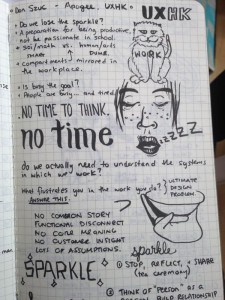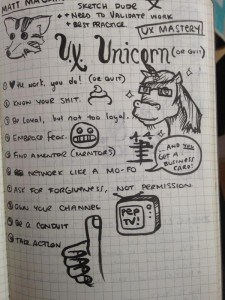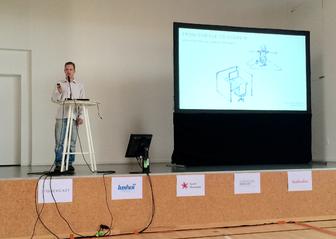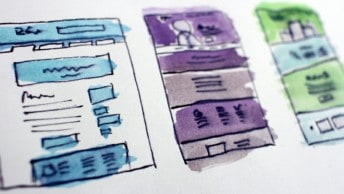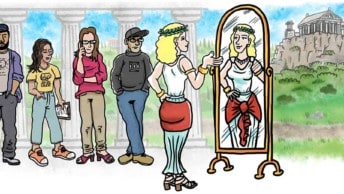Last week, Luke, Hawk and I attended Webstock in Wellington, New Zealand.
The day after, coincidentally, was World IA Day, a global series of free one-day conferences for anyone interested in Information Architecture.
The team from Optimal Workshop (the guys behind the event) got wind that we were in town, and invited me to speak at the Wellington event. This was a real honour—especially when I discovered that I would be on stage immediately after the opening keynote from Jesse James Garrett, author of the first UX book I ever read (I think I’ve read it about six times).
My talk was well received, if some of the comments in person and on Twitter afterwards are any indication. Below are the slides from my talk, which I titled From Cubicle to Cloud 9: 10 Tips For Architecting UX Career Happiness.
For those who are interested, a complete transcript of my presentation follows.
From Cubicle to Cloud 9: 10 Tips For Architecting UX Career Happiness
Hello! What a fantastic event. Please join me in giving a round of applause to Samantha and everyone involved in World IA Day for putting on such a great show. And thank you too, Samantha, for scheduling me directly after Jesse James Garrett—I really can’t thank you enough for that one!
Actually it is kind of poetic, because Jesse James’s book, The Elements of User Experience, is the very first UX book I ever read. Honestly, your book set in motion a chain of events that lead me to be here on stage today, so I really am honoured, and mildly terrified, to be here.
You’ll hear a bit today about making our users and our customers happy; I’m going to interpret the theme of “architecting happiness” a little differently—I’m going to talk about making ourselves happy. Happy in our jobs, and happy with our career.
Now I don’t profess to be any kind of happiness guru. But I do love what I do. It makes me happy. And I’ve been told that my story is a pretty good one, so I’m going to do my best to tell it to you today.
Now, some of you may be wondering … hmm, this guy’s just getting up and talking about himself. That’s kind of indulgent.
And you’re right, it is.
But you see, I have a bit more license than usual today, because today is in fact, my birthday.
Happy Birthday to me!
Yes, I turn 39 years old today … so I do feel like I can get away with standing on stage, reflecting on my career, in a way that I may not otherwise be able to.
So I’m going to tell my story—the various roles I’ve worked in, how I’ve architected my own happiness, and then some tips that I hope you find helpful to architect your own career so that you’re happier. I’ve tried not to make them the usual career advice guff.
But first things first—who am I, and why should you care?
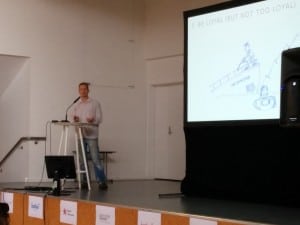
That guy who draws stuff
Well, my name’s Matt, and I’m that guy who draws stuff. Specifically, I visualise information.
Sometimes that’s in the form of custom illustration, sometimes it’s an animated video, sometimes it’s wireframes or concepts for some other digital product, and sometimes it’s the real-time capture of a conference or meeting … I also have a kids’ book that I wrote and illustrated. So I’m a bit all over the place, but that common thread in everything I do is that I love communicating with visual language, bringing information to life with visuals.
And what’s interesting is that I’ve only just realised this in the last year or two. And it’s this funny phrase that entered the zeitgeist about 6 or 7 years ago, “UX”, that has allowed me to explore it and, in a sense, find myself and articulate what it is that I’m passionate about.
Having strong visual thinking skills turns out to be very useful for more than just making kids books. There is a slew of books that have come out in the last 5 years or so about how improving your visual literacy is good for business and being creative.
My career can be broken up into a bunch of phases.
- First there was the code monkey phase.
- Next came the artistic instructor phase.
- Then I entered the word nerd phase.
- After that came the pixel pusher phase.
- After that came the UX unicorn phase.
- And then finally I arrived at the vivacious visualiser phase. I couldn’t think of an adjective that started with “V”, so Beyoncé it is.
And the beautiful thing about each of those roles that I’ve had is that they all fall under the UX umbrella. There’s no such thing as a UX specialist—UX is this convenient container that we can use to lump a bunch of principles, and process, and roles, and values, into one container. And what that means for those of us who operate in this space is that there’s a lot of space to move around, and try new things, and grow professionally and personally. There are always times when you feel like you’re in a rut, or your work doesn’t feel satisfying … and when you get to that place—and we all arrive there at some point—then you can take action without having a mid-life crisis and doing something drastic.
Finding the thread
So let me take you back to when I was a kid. Here’s a shot of me as a creative, curious, awkward teenager. I think I was about fifteen in this pictures. And if I wasn’t on the computer, I’d be drawing. I’d spend hours creating these elaborate comics and caricatures and doodling.
And it wasn’t just in my spare time that I drew. My old note books from school are full of little works of art that weren’t part of class but I threw in there anyway. What I realised from looking through these is that I’ve actually always created visual notes, even as a kid.
This was an essay we had to write about the ANZACs in World War I. And for some reason I’ve complemented my essay with this bizarre drawing of soldiers shooting each other with big smiles on their faces. I’m not sure that I fully grasped exactly what it must have been like to be at war as an 8 year old!
I’m sure you guys probably drew a lot as kids too, right? For me it continued through to university. And while I enjoyed art and design, I also had a knack for maths and science. So when it came to deciding what to study at university, of course I went with the sensible option of pursuing something left-brained and technical.
Code Monkey
So the code monkey phase started at uni. My parents, my peers, everyone expected me to. And I enjoyed using computers, so why wouldn’t I? So I studied engineering at university: Computer Systems Engineering, and went on to become a software developer.
Yet even in my university notebooks I was using visual design principles to help me understand and recall information, or make it easier to read. So you can see things like type, colour, containers, whitespace, and alignment and all of these design principles that made my notes look so neat and ordered and easier to read, and more fun!
And because I was immersed in large electric motors and complex sorting algorithms and compilers and calculations, I stopped doing anything visually creative. And in doing so, I think a little part of me died. I felt hollow and numb. And when I scored a great job straight out of university with a Big 5 consulting company, no matter how many great projects I got to work on, and some of these were really large, global, complex, ambitious software projects, I never truly felt excited about any of them.
And so I walked away.
At 25 years old I was earning really good money as an IT consultant, and I walked away because I couldn’t stomach it. I was yearning for something more. I just didn’t know what.
So, like many Australians who don’t know what to do with their life, I ran away to Japan to teach English and think things over.
Artistic Instructor
My girlfriend at the time (now my wife) and I applied as a couple to teach English in Tokyo, and worked for the same company for 3 years. I taught in primary schools and junior high schools, and my wife taught air hostesses at an airline. And this was a great experience. Naturally, travel is always good for the soul and a terrific way to gain some perspective and work out what it is you should be doing with your life. And that was true for both of us.
But in particular, teaching English in schools gave me the opportunity to draw again … I got to create worksheets and board games and make learning fun for my students … and because I was studying the language while I was there, I also explored ways that visual language could help my own learning, by creating these crazy illustrated mnemonics to help remember the Kanji characters. I was learning lots, I was having fun.
But I was worried.
I was worried that once we decided to leave Japan, I’d go back to Australia and be unemployable. Because keeping up with the tools and the languages and the browser quirks is a constant race, and after taking a break I wasn’t sure that I’d be able to catch up with it all. So I started tinkering with websites, and these things called blogs, which were just starting to get some momentum. And that was how I felt connected, by tinkering with web technologies like HTML and CSS and PHP and JavaScript.
And what I discovered was that this was the medium I’d been craving—it was perfect for me. It let me be both technical and creative! I could design something, then I could build it, and there was this incredibly satisfying feedback loop that was infectious. So after launching a handful of personal websites and getting a small taste of success, I was hooked.
Word Nerd
When I came back to Australia, I knew I wanted to work on the web, but my design chops weren’t good enough to get hired as a web designer. I tried my hand at freelancing, but I wasn’t disciplined enough and ended up finding a job with a company that published computer books, called SitePoint. I was hired as a technical editor, and I got to combine my love of language with my technical skills.
Plus, it was a lot of fun! It really did save my career, in a way. I went from dreading going into work, dreading the grey suit wearing, corporate boys club in my old IT job, to loving what I was doing. Sure, I took a massive pay cut, but I also had fun at work for the first time in a while. Fun! Fun is under-rated. There are a lot of jobs that aren’t fun, so when you find one, embrace it.
Pixel Pusher
While I was at SitePoint I finally got to make the move from editing books to actually doing design. Sure, I’d been doing a little bit of design on the side, freelance, but this was the first time someone had employed me in a full-time capacity as a designer, and I was super proud! I got to spend lots of time in Photoshop, and argue with front-end developers about how many pixels high a button should be, and make design decisions about web properties that were visited by millions of people. It was great.
But I hit some hurdles too. You can probably sum up these hurdles with the phrase “stakeholder management”. The owner, and the other owner, and the general manager, and the finance guy—each of them had different ideas about what the design should look like. And I didn’t know how to manage that. I had my own ideas, and I tried my best to defend my design decisions while still taking everyone else’s views into account, but at the end of the day, on reflection, I knew how to create something that I thought was functional and looked pretty good, but I didn’t know how to validate design, and I was inexperienced at communicating design effectively.
That’s when I first started hearing this term “UX”.
UX Unicorn
I worked with someone from Hiser who had been doing usability for years, and he opened my eyes to the techniques that we all know and love today. At the same time I was fortunate enough to approach an interaction designer who I knew and respected, to ask him how it was he did what he did. And over the course of a bunch of coffee chats, he broke down to me his process and the techniques that he considered “best practice”. Things like usability testing, low-fidelity prototyping, transparency, collaborative design techniques, creating personas and storyboards.
So I read a ton, I met regularly mentor, and I started applying a bunch of these techniques at work. And when I tried them on a big project at work, what do you know, they worked? The web app I designed was lauded in the tech media for having “one of the simplest interfaces for putting together online content I’ve seen—and I mean that in the best possible way.”
This skill of being able to conduct user-centred design was in pretty hot demand, and it was at that point that I decided to leave my salaried job and try my hand at working freelance. I was lucky enough to work on some great projects that won awards and I felt like this new-found knowledge was quite transformational, really, for my design education and for my own career.
And I felt an obligation to share what I’d learned with others. So I teamed up with a friend of mine to start a website called UX Mastery, and together we started writing blog posts that taught other people about UX. Beginner stuff really—what are personas? How do you do card sorting? How do you create a customer experience map? It turned out that people liked the content we were putting out, and asked us to write ebooks about UX, and teach workshops, and that’s been an incredible ride so far. Luke and I have had some incredible opportunities off the back of having a popular blog.
Vivacious Visualizer
One thing that we did well when we launched UX Mastery was we made a launch video that answered the question What the @#$% is UX? And we did it as a whiteboard animation. My next door neighbour is a freelance videographer for some of the TV stations in Melbourne, so in exchange for redesigning his website, he agreed to shoot and edit this video that answered the question “What is UX?”
And at last count the video has had over 200,000 views, which at 3 minutes is nearly 150 years of that annoying background music track!
One of my clients at the time, Australia Post, saw the video, and asked if they could have one for their business, so then I was getting paid to make these videos for the first time. And I had one of those moments where I thought “Hey, I’m getting paid to draw pictures!
My cousin is this struggling cartoonist who, his whole life, has submitted one comic strip after another to newspapers and never quite got his big break … and here I was, living the dream.
A couple of months later I was working at a client, and while I was on my lunch break I got this call from a PR firm who had found my article about sketchnoting on UX Mastery. They were calling to ask whether I made sketch videos. They had a client who wanted one and was based in Canberra, but they wouldn’t tell me who it was.
And I was a bit thrown, partly because I was at another client, and I have this strong ethical drive to be completely focussed on the client who premises I’m currently at. But also because I’d only made two of them! But I said, “Sure, I can make your video.”
There were going to be some very tight timeframes, and they wouldn’t be able to get me a final script until the very last minute. But I was prepared to step up, and once I’d signed an NDA I discovered that this video was about the Federal Budget. That video clocked up 50,000 page views in the first day that it was published to the Labor Party’s home page. And fortunately I managed to negotiate a name credit at the end of the video, so the next day I got a bunch of calls, and the inquiries for making sketch videos kind of snowballed from there.
So now I split my time between making sketch videos and writing UX Mastery ebooks and newsletters and presenting about UX at conferences in exotic far-off lands like New Zealand.
And so we come to today, when, because it’s my birthday, and I get to look back and think: wow—what I’m doing … really is how I want to be spending my time. I’ve architected my career to make myself happier. And I feel very fortunate that all of the opportunities. I’ve had sit under the UX umbrella, because I haven’t had to chuck in the towel six times to evolve my career. I’ve just been able to shimmy sideways.
Sure, I’ve had some lucky breaks and some incredible opportunities that at the time feel like they landed in my lap. But that PR firm wouldn’t have called me if I hadn’t written that article about sketchnoting. Luke and I wouldn’t have been invited to teach our UX workshop in Malaysia and The Philippines if we hadn’t started doing it in Melbourne and writing about it in our email newsletter. You make your own luck. I really believe that. And you can architect your own happiness.
So anyway, that’s enough about me! Here are 10 tips that I came up with for architecting a career that makes you happy, based on my humble experience.
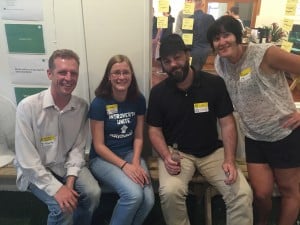
10 Tips for Architecting UX Career Happiness
1: Love the work you do, or quit.
This may already be the case for you. Or maybe you’re still searching for your “thing”. That’s OK. But don’t complain about not loving your job and not do anything about it. Take pride in your work, or quit. We all know someone like that, who’s unhappy in their job but doesn’t do anything about it.
If you’re curious, there’s a wonderful website called zenpencils.com, it’s a webcomic from a fellow Melbournian, Gavin Aung Than, where he takes inspirational quotes and makes comics out of them. He has a book of some of his best comics too, which I highly recommend. One of his comics is a quote from Kahlil Gibran’s The Prophet, and the line is “Work is love made visible”. And I love that line, especially for someone whose job is visuals. Check out zenpencils, Gavin does amazing work.
2. Know your shit.
And that’s not to say that you need to strive to be the number one world authority on a topic. But mastery is certainly a worthy goal, because it’s satisfying to do great work. Doing great work makes us happy, and it’s hard to do great work when you’re still coming to grips with the basics.
3: Be loyal. But not too loyal.
Loyalty is definitely a great quality to have. But it’s better for your employer.
At one point in my career I was in a job that I probably should have left way before I finally did. I was good at what I did, but I was closed to the idea of taking on new opportunities because I was so bought into the culture of the place. I loved my job, I loved the people I was working with, and I love the vision of the company … until one day I didn’t, and it took me a while to do anything about it. You have to look after number 1 first—no-one else is going to look out for your career. It needs to be you.
Which leads me to my next point …
4. Embrace fear.
One of my mentors told me that fear was an indicator that something big was about to happen. And when you look at it in that context, it becomes a good thing, and it’s something you shouldn’t shy away from. For me, taking the leap to go freelance was massively scary, as was agreeing to make a video for the Federal Government of Australia when I’d never tackled something that big before. Drawing on film—I was a bit nervous and my hand was a bit shaky initially, but then I got over it.
Getting up and speaking on stage was a big one too—my first public speaking gig was terrifying. But I got through it, and the next one was a little bit better. And the one after that, and I still have a lot to learn, but I know that I’ve come such a long way, because speaking to a crowd used to terrify me, and now I actually get a real buzz out of it.
So challenge yourself! Push yourself outside of your comfort zone. That’s where we grow and where we learn. And without growing or learning we’ll never reach our potential.
5. Find a mentor
Some of the key moments in my career have come about because my mentor pushed me into stepping out of my comfort zone. My mentor is the one who told me I should get up on stage and speak at an event. It was terrifying! But I did it. And I was pretty average.
And then I did it again and again, and over time I got better at it. I know I still have a lot to learn about public speaking. But I know I’ve come a long way.
I also recommend you find multiple mentors, because you’ll learn something different from each of them. They’ll each have their own areas of expertise and their own way of looking at things.
If you want to talk more about the process of finding mentors and how that works, come talk to me after.
6. Network like a mo-fo.
This is something that I kind of do naturally, but I know lots of people are shy about putting themselves out there at events. You’ve got to meet people and connect with them and form relationships with the foiks in your industry. It’s the best way to find work, find a job, find a mentor, and understand what’s possible for you. Events like this are a great start, but don’t spend the times in-between each session just chatting with your mates—go up to a stranger, introduce yourself and make a new friend. Creative people often want to sit in their room and create, and I get that. But if you ignore networking then you’re shutting off so many opportunities, so be social!
7. Ask for forgiveness, not permission.
I’m aware this one’s a little contentious.
I’ve deliberately been a little vague about this tip—it could relate to running some budget usability testing at work that your boss won’t fund. Or doing some other research so that you’re making better informed decisions … or it could relate to something more personal like changing jobs. Obviously it doesn’t apply in all situations—if you’re married, and you decide one day that you’re going to leave your $100K/year job to be a full-time street busker, then you may want to have a conversation with your spouse before you take that leap.
But really, at the end of the day, you do need to do what’s going to make you happy. And sometimes that means being a little bit selfish and backing yourself that it will pay off. Because it’s possible that others won’t believe in you.
If you believe in yourself, even if others don’t, then you should just do it, and ask for forgiveness, because permission may not be forthcoming. You have to look after number 1!
8. Own your channel.
I’m talking here about personal brand and social media … it can be very tempting to try and be everywhere. I’m saying you don’t have to be—but if you decide to spend time on building a brand on Twitter, or Flickr, or YouTube, then you need to do it right. It’s better to have an awesome YouTube channel than to have a half-arsed one because you’re spending so much other time posting to Instagram and Facebook and Twitter and whatever else.
9: Be a conduit.
This is something I also realised that I sometimes did naturally, but didn’t realise that people saw so much value in it. I’ve referred a ton of friends to awesome jobs, and never really thought that it was that valuable until I thought about the fact that there’s this entire industry called recruiting, that’s big money.
So be generous in connecting others, and it will come back in spades.
10. Take action.
This sounds like a cop-out but it’s an important reminder that reading about how to find our passion, reading about the latest techniques or approaches to research is all well and good, but nothing will change for you unless you put them into action.
Whether that means trying a new technique at work, or taking on a freelance client on the side as a way of dipping your toes into working for yourself, or taking the leap to quit your job and try something ambitious, I encourage you to be bold, because nobody ever achieved great things by playing it safe.
One more thing …
There’s one other thing I haven’t mentioned.
Two days ago I received some news from back home that knocked the wind out of me a bit. A friend of mine’s young son passed away, and that incident made me look at this talk in a whole new perspective. Like, here I am on stage talking about myself and what a great time I’m having doing what I love. But really, what does it matter when shit like that happens.
And the feeling of helplessness that I experienced, and some of my friends who are here were also impacted, as he and his family grieve, was a pretty solid reminder of one more important motivation for how to make sure that what you’re doing makes you happy.
And that’s your own family.
I don’t know how this happened, but I have these two devastatingly beautiful daughters.
I mean, I do know how it happened, but I’m continually baffled at how beautiful they are and what lovely, strong, women they’ll grow up to be. And so all of this “find your calling” stuff is important. But being able to spend time with the people who are important in your life—that’s what guides me. The fact that I work for myself means I get to do school drop-offs and pickups, and be there for important stuff, and any parent in the room will know that that’s priceless.
So anyway, that’s all I have for you. Thank you for making my birthday a memorable one. Please connect with me—my details are on the screen. And please find me today and come say hello. UX Mastery is the website that Luke and I run. The whole UX Mastery team is here today, actually, so come say hi. I wish you all the best in your journey to happiness.
Thank you.
